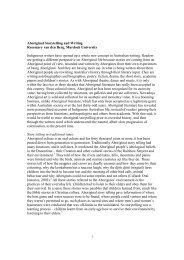Polona Petek - [API] Network
Polona Petek - [API] Network
Polona Petek - [API] Network
You also want an ePaper? Increase the reach of your titles
YUMPU automatically turns print PDFs into web optimized ePapers that Google loves.
<strong>Polona</strong> <strong>Petek</strong>allows the viewer to read the lot, Pamela picks out only the two most suggestiveones: I love and approve of myself and I deserve the best and I accept the best.With her face, posture and articulation distorted because she is simultaneouslycleaning her teeth, the image of Pamela and the words she is uttering are in odddiscord. This motif of self-observation and self-audition, combined with‘rehearsals’ of how to behave or speak to be most likable, is repeated at severalpoints in the film and quite accurately illustrates Rank’s and Freud’s ideas aboutthe ambiguity of the double, that is, about its oscillation between self-love and fearor loathing or at least lack of confidence in one’s self. Significantly, this is true ofthe scenes in which Pamela interacts with her reflection in the mirror. As soon asher double materialises in flesh and blood, considerable discrepancies develop.Narcissism is worth considering on yet another level of the film, that is, outsidethe diegesis. Following Teresa de Lauretis, 12 Mary Ann Doane identifies ‘theprevailing notion of woman’s narcissistic overidentification with the image’ inclassical Hollywood cinema. 13 This ‘prevailing notion’ is based on the same kindof reasoning that supports Freud’s assertion of the intensification of narcissism inwomen. In other words, ‘the transformation of the woman into spectacle is easy’because the female herself collapses the distance between herself (as the subject)and the image (as spectacle, as the object). 14 This is the first point where MeMyself I challenges the ‘prevailing notion’ of female narcissism. The double hasalways been a particularly fascinating challenge to cinema as a medium: fromStellan Rye and Paul Wegener’s The Student of Prague (1913) to DavidCronenberg’s Dead Ringers (1988) and beyond, film reviewers and scholars havenever failed to observe the techniques employed to heighten the attraction as wellas the verisimilitude of its visual representation. Indeed, the double lends itselfeasily to ‘transformation into spectacle’. 15 Yet, Me Myself I never exploits thispotential (the double remains a narrative element throughout the film), althoughthe instances of spectacle — in most cases attached to Pamela’s confrontation witha mirror or an old photograph from her past — are hardly scarce in the film.Karmel’s feature makes use of them to destabilise any possibility of the viewer’snarcissistic identification with the diegetic woman. The underlying pattern thatstructures spectacle in the film is paradox.Spectacle in Me Myself I works in two contradicting layers: one supports thenarcissistic reading, the other denies Pamela the status of a point of identificationfor the spectator. After Pamela’s dinner, organised through a personaladvertisement, the camera cuts to a shot of her bedroom. The viewers hear thepanting of a man and a woman in voice-over, while the camera tracks along bedlinen and Pamela’s clothes crumpled on the floor to a burning photo of her dinnerdateuntil it focuses on Pamela drinking and watching pornographic tapes (andthus eliminates any doubts as to the source of the voices). Unimpressed, Pamelastarts looking at the photos of her old lovers, which are revealed to the audiencethrough a fast-edited montage that somewhat pauses the narrative and emphasisesher feeling of having reached a dead-end. The music, firmly located in the diegesisthrough Pamela’s walkman, escalates and thus functions to support KajaSilverman’s argument about music being a means of evoking the feeling ofinfantile plenitude (corresponding to the stage of primary narcissism). 16 Suddenly,the images and the sound slow down as Pamela finds the photo of the161


![Polona Petek - [API] Network](https://img.yumpu.com/40542952/3/500x640/polona-petek-api-network.jpg)
![Dream and Nightmare in William Gibson's ... - [API] Network](https://img.yumpu.com/49298598/1/184x260/dream-and-nightmare-in-william-gibsons-api-network.jpg?quality=85)

!['Fuck All Editors': The Ern Malley Affair and Gwen ... - [API] Network](https://img.yumpu.com/42446228/1/184x260/fuck-all-editors-the-ern-malley-affair-and-gwen-api-network.jpg?quality=85)
![to download as a PDF. - [API] Network](https://img.yumpu.com/35170825/1/184x260/to-download-as-a-pdf-api-network.jpg?quality=85)
![Edward Koiki Mabo: The Journey to Native Title - [API] Network](https://img.yumpu.com/33197148/1/184x260/edward-koiki-mabo-the-journey-to-native-title-api-network.jpg?quality=85)
![Gallipoli, Kokoda and the Making of National Identity - [API] Network](https://img.yumpu.com/31766380/1/184x260/gallipoli-kokoda-and-the-making-of-national-identity-api-network.jpg?quality=85)
![Indigenous Knowledge and Pharmaceuticals - [API] Network](https://img.yumpu.com/24108846/1/184x260/indigenous-knowledge-and-pharmaceuticals-api-network.jpg?quality=85)
![Ferals: Terra-ism and Radical Ecologism in Australia - [API] Network](https://img.yumpu.com/13809010/1/184x260/ferals-terra-ism-and-radical-ecologism-in-australia-api-network.jpg?quality=85)
![Big Chief Little Wolf: Wrestling, Radio and Folklore in ... - [API] Network](https://img.yumpu.com/12204748/1/184x260/big-chief-little-wolf-wrestling-radio-and-folklore-in-api-network.jpg?quality=85)
![Dark Tourism and the Celebrity Prisoner - [API] Network](https://img.yumpu.com/4348795/1/184x260/dark-tourism-and-the-celebrity-prisoner-api-network.jpg?quality=85)